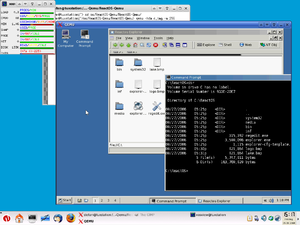QEMU
 |
|

|
|
| Original author(s) | Fabrice Bellard |
|---|---|
| Developer(s) | QEMU team: Peter Maydell, et al. |
| Stable release |
2.8.0 / December 21, 2016
|
| Repository | git |
| Written in | C |
| Operating system | Linux, Microsoft Windows, macOS and some other UNIX platforms |
| Type | Hypervisor |
| License | GNU GPL version 2 |
| Website | qemu |
QEMU (short for Quick Emulator) is a free and open-source hosted hypervisor that performs hardware virtualization (not to be confused with hardware-assisted virtualization).
QEMU is a hosted virtual machine monitor: it emulates CPUs through dynamic binary translation and provides a set of device models, enabling it to run a variety of unmodified guest operating systems. It also can be used together with KVM in order to run virtual machines at near-native speed (requiring hardware virtualization extensions on x86 machines). QEMU can also do CPU emulation for user-level processes, allowing applications compiled for one architecture to run on another.
QEMU was written by Fabrice Bellard and is free software and is mainly licensed under GNU General Public License (GPL). Various parts are released under BSD license, GNU Lesser General Public License (LGPL) or other GPL-compatible licenses. There is an option to use the proprietary FMOD library when running on Microsoft Windows, which, if used, disqualifies the use of a single open source software license. However, the default is to use DirectSound.
QEMU has multiple operating modes:
QEMU can save and restore the state of the virtual machine with all programs running. Guest operating-systems do not need patching in order to run inside QEMU.
...
Wikipedia
